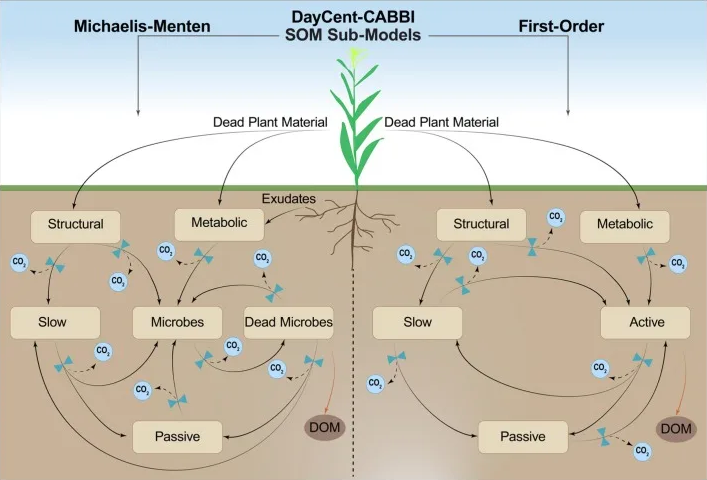
DayCent-CABBI: New Model Integrates Soil Microbes, Large Perennial Grasses
Original article by April Wendling and Anjali Yedavalli can be found here on CABBI’s website.

Of all the carbon stored in ecosystems around the world, about half can be found in soils. Depending on climate, vegetation, and management, soils can be either a carbon source or a sink.
Natural climate solutions (NCS) offer a promising opportunity to bring us closer to our net-zero emissions goals by removing carbon dioxide from the atmosphere and storing it in plant biomass and soil. The growth of bioenergy feedstocks has great potential in this regard, because these grasses both build soil carbon and have the potential to be used to produce carbon-neutral biofuels and bioproducts.
Over the last 40 years, biogeochemical models have been a crucial tool that researchers use to understand how climate, ecological disturbance, and land management affect carbon and other fluxes in an ecosystem. Due to their success, biogeochemical models are gaining traction as important tools to evaluate the efficacy of NCS. These models can be used to inform management and policy decisions.
One of these models, called DayCent, simulates daily fluxes of carbon, nitrogen, and water between the atmosphere, vegetation, and soil. However, projecting the potential of large perennial bioenergy crops as NCS was challenging due to two limitations of previous versions of the DayCent model. Like many ecosystem models, DayCent did not explicitly model soil microbes and the role they play as drivers of soil carbon cycling. Additionally, large perennial grasses like miscanthus and switchgrass have distinct physiological traits that are not accounted for in many model frameworks.
To remedy this issue, a CABBI research team in the Sustainability Theme has developed DayCent-CABBI, a model that integrates soil microbes and the distinct physiological traits of large perennial grasses into DayCent.
In a new paper published in Geoderma, the researchers discuss the development and validation of DayCent-CABBI — and put its predictive power to the test.
“Adding new plant and microbe components to the DayCent-CABBI model improves its representation of ecosystem dynamics,” said Melannie Hartman, a lead author on the study and Senior Research Associate at Colorado State University. “These advancements enhance the model’s ability to evaluate the sustainability of growing different types of bioenergy crops.”
Microbes in the soil contribute to significant carbon storage and fluxes, so the research team updated DayCent to include a live microbial biomass pool. This feature regulates the release of carbon dioxide to the atmosphere based on its pool size. They also added a dead microbial biomass pool that allows for a more realistic representation for carbon to flow from one pool to another, which will better simulate carbon storage in soil.
“Microbes are important to include in the model because, for example, dead microbial biomass carbon is more likely to be retained in the soil system for decades to millennia if it has a strong bond to soil mineral surfaces,” said Danielle Berardi, lead author and recent graduate with an Ecology Ph.D. from the University of Idaho. “The maximum capacity of this type of soil carbon in a given system is based on the soil texture, which determines the available surface area for carbon to bond to. We have improved how mineral associated organic matter is represented in DayCent, which is crucial for modeling measurable soil organic matter pools.”
The other significant change the team made focused on more accurately modeling different parts of perennial plants. Traditional models have lumped together leaves and stems as “aboveground plant components.” Splitting up these plant parts and modeling them separately allows DayCent-CABBI to more accurately simulate carbon, nitrogen, and lignin content for each, both improving how plant growth is simulated as well as providing more realistic litter chemistry and more versatile harvest options with implications for soil carbon and nitrogen cycling. In addition, the team added a rhizome component to the model. Rhizomes are shallow perennial roots that store carbohydrates and nitrogen during the dormant season when aboveground plant parts have withered. Because these root systems in bioenergy crops like miscanthus aren’t adapted for harsh winters that they may face in the central U.S., the researchers added a temperature threshold for the rhizomes – once temperatures drop far enough, the model will simulate damage to the rhizomes.
With these modifications, the researchers put DayCent-CABBI to the test by simulating switchgrass and miscanthus at the University of Illinois Energy Farm from 2008 to 2049. The model was calibrated and evaluated using field data from 2008 to 2019. When compared to historical data, the version of the model with the new microbial-explicit soil model had better model-data agreement with daily ecosystem carbon fluxes, particularly in the springtime, indicating that this modification does indeed improve DayCent’s ability to accurately assess the potential of perennial grasses as NCS.
Under future simulations (2020-2049), the version of DayCent using the previous soil model simulated continually increasing soil carbon into the future for both crops, whereas the new version simulated an eventual plateau of soil carbon before 2049. This plateau represents the researchers’ best understanding of future soil carbon fluxes and stabilization in miscanthus and switchgrass.
“These much-needed modeling advances benefit not only CABBI but also the greater community of researchers and stakeholders who want to estimate the carbon intensity of growing high-yielding perennial grasses for biofuel and bioproduct production,” said co-author Wendy Yang, CABBI’s Sustainability Theme Leader and a Professor of Plant Biology at the University of Illinois Urbana-Champaign.
Co-authors on this study include West Virginia University Associate Professor of Forest Ecology and Ecosystem Modeling Edward Brzostek; University of Idaho Associate Professor of Forest, Rangeland and Fire Sciences Tara Hudiburg; Colorado State University Senior Research Scientist William Parton; USDA ARS Research Plant Physiologist Carl Bernacchi; University of Illinois Professor Emeritus of Plant Biology Evan H. DeLucia; Illinois Postdoc Adam von Haden; Illinois Postdoc Ilsa Kantola; and University of Western Australia School of Agriculture and Environment lecturer Caitlin Moore.